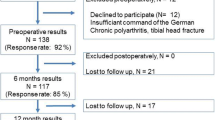Abstract
Purpose
The purpose of the study was to investigate if changes in psychological variables are related to the outcome in pain and disability in patients with chronic anterior knee pain.
Methods
A longitudinal observational study on 47 patients with chronic anterior knee pain was performed in a secondary healthcare setting. Pain was measured with the visual analogue scale and disability with the Lysholm scale. The psychological variables, such as anxiety, depression, pain coping strategies, catastrophizing and fear to movement beliefs, were studied by using self-administered questionnaires.
Results
Among the pain coping strategies, only the catastrophizing subscale showed a significant reduction. Similarly, anxiety, depression and kinesiophobia were significantly reduced after treatment. Those patients who decreased the catastrophizing, kinesiophobia, anxiety and depression showed a greater improvement in pain and disability after a purely biomedical treatment. A multiple regression analysis revealed that changes in catastrophizing predicted the amount of improvement in pain severity and that changes in both catastrophizing and anxiety predicted changes in disability after treatment.
Conclusion
What has been found suggests that clinical improvement in pain and disability is associated with a reduction in catastrophizing and kinesiophobia. Therefore, co-interventions to reduce catastrophizing thinking and kinesiophobia may enhance the results.
Level of evidence
Prospective Cohort Study, Level I for prognosis.
Similar content being viewed by others
References
Boeckstyns MEH, Backer M (1989) Reliability and validity of the evaluation of pain in patients with total knee replacement. Pain 38:29–33
Briggs KK, Lysholm J, Tegner Y, Rodkey WG, Kocher MS, Steadman JR (2009) The reliability, validity, and responsiveness of the Lysholm score and Tegner activity scale for anterior cruciate ligament injuries of the knee: 25 years later. Am J Sports Med 37:890–897
Brox JI, Sørensen R, Friis A, Nygaard Ø, Indahl A, Keller A, Ingebrigtsen T, Eriksen HR, Holm I, Koller AK, Riise R, Reikerås O (2003) Randomized clinical trial of lumbar instrumented fusion and cognitive intervention and exercises in patients with chronic low back pain and disc degeneration. Spine 28:1913–1921
Burns JW, Glenn B, Bruehl S, Harden RN, Lofland K (2003) Cognitive factors influence outcome following multidisciplinary chronic pain treatment: a replication and extension of a cross-lagged panel analysis. Behav Res Ther 41:1163–1182
Chmielewski TL, Zeppieri G Jr, Lentz TA, Tillman SM, Moser MW, Indelicato PA, George SZ (2011) Longitudinal changes in psychosocial factors and their association with knee pain and function after anterior cruciate ligament reconstruction. Phys Ther 91(9):1355–1366
Crombez G, Eccleston C, Baeyens F (1998) When somatic information threatens, catastrophic thinking enhances attentional interference. Pain 75:187–198
De Das S, Vranceanu AM, Ring DC (2013) Contribution of kinesophobia and catastrophic thinking to upper-extremity-specific disability. J Bone Joint Surg Am 95:76–81
Domenech J, Sanchis-Alfonso V, Lopez L, Espejo B (2013) Influence of kinesiophobia and catastrophizing on pain and disability in anterior knee pain patients. Knee Surg Sports Traumatol Arthrosc 21:1562–1568
Edward RR, Smith MT, Stonerock G et al (2006) Pain-related catastrophizing in healthy women is associated with greater temporal summation of and reduced habituation to thermal pain. Clin J Pain 22:730–737
Edwards RR, Giles J, Bingham CO III, Campbell C, Haythornthwaite JA, Bathon J (2010) Moderators of the negative effects of catastrophizing in arthritis. Pain Med 11:591–599
García Campayo J, Rodero B, Alda M, Sobradiel N, Montero J, Moreno S (2008) Validación de la versión española de la Pain Catastrophizing Scale en pacientes con fibromialgia. Med Clin 131:487–492
Gracely RH, Geisser ME, Giesecke T (2004) Pain catastrophizing and neural responses to pain among persons with fibromyalgia. Brain 127:835–843
Herrero MJ, Blanch J, Peri JM et al (2003) A validation study of the hospital anxiety and depression scale (HADS) in a Spanish population. Gen Hosp Psychiatry 25:277–283
Jensen MP, Karoly P, O’Riordan EF, Bland F Jr, Burns RS (1989) The subjective experience of acute pain: an assessment of the utility of 10 indices. Clin J Pain 5:153–159
Johnson LL, van Dyk GE, Green JR (1998) Clinical assessment of asymptomatic knees: comparison of men and women. Arthroscopy 14:347–359
Keefe FJ, Affleck G, Lefebvre JC (1997) Pain coping strategies and coping efficacy in rheumatoid arthritis: a daily process analysis. Pain 69:35–42
Kori KS, Miller RP, Todd DD (1990) Kinesiophobia: a new view of chronic pain behaviour. Pain Manag 3:35–43
Leeuw M, Goossens ME, Linton SJ, Crombez G, Boersma K, Vlaeyen JW (2007) The fear-avoidance model of musculoskeletal pain: current state of scientific evidence. J Behav Med 30:77–94
Leeuw M, Goossens ME, van Breukelen GJ, de Jong JR, Heuts PH, Smeets RJ, Köke AJ, Vlaeyen JW (2008) Exposure in vivo versus operant graded activity in chronic low back pain patients: results of a randomized controlled trial. Pain 138:192–207
Linton SJ, Nordin E (2006) A 5-year follow-up evaluation of the health and economic consequences of an early cognitive behavioral intervention for back pain: a randomized, controlled trial. Spine 15:853–858
Macintyre NJ, Hill NA, Fellows RA (2006) Patellofemoral joint kinematics in individuals with and without patellofemoral pain syndrome. J Bone Joint Surg 88A:2596–2605
Peters ML, Vlaeyen JWS, Weber WEJ (2005) The joint contribution of physical pathology, pain-related fear and catastrophizing to chronic back pain disability. Pain 113:45–50
Picavet HSJ, Vlaeyen JWS, Schouten SAG (2002) Pain catastrophizing and kinesiophobia: predictors of chronic low back pain. Am J Epidemiol 156:1028–1034
Piva SR, Fitzgerald GK, Wisniewski S, Delitto A (2009) Predictors of pain and function outcome after rehabilitation in patients with patellofemoral pain syndrome. J Rehabil Med 41:604–612
Powers CM, Bolgla LA, Callaghan MJ, Collins N, Sheehan FT (2012) Patellofemoral pain: proximal, distal, and local factors, 2nd international research retreat. J Orthop Sports Phys Ther 42:A1–A54
Rainville J, Smeets RJ, Bendix T, Tveito TH, Poiraudeau S, Indahl AJ (2011) Fear-avoidance beliefs and pain avoidance in low back pain-translating research into clinical practice. Spine J 11:895–903
Riddle DL, Wade JB, Jiranek WA, Kong X (2010) Preoperative pain catastrophizing predicts pain outcome after knee arthroplasty. Clin Orthop Relat Res 468(3):798–806
Rodríguez Franco L, Cano García FJ, Blanco Picabia A (2004) Evaluación de las estrategias de afrontamiento del dolor crónico. Actas Esp Psiq 32:82–91
Rosenstiel AK, Keefe FJ (1983) The use of coping strategies in chronic low back pain patients: relationship to patient characteristics and current adjustment. Pain 17:33–44
Sanchis-Alfonso V (2014) Holistic approach to understanding the anterior knee pain. Clinical implications. Knee Surg Sports Traumatol Arthrosc (in press)
Smeets RJ, Vlaeyen JW, Kester AD, Knottnerus JA (2006) Reduction of pain catastrophizing mediates the outcome of both physical and cognitive-behavioral treatment in chronic low back pain. J Pain 7:261–271
Sullivan HJL, Bishop SR, Pivik J (1995) The Pain Catastrophizing Scale: development and validation. Psychol Assess 7:524–532
Sullivan M, Tanzer M, Stanish W, Fallaha M, Keefe FJ, Simmonds M, Dunbar M (2009) Psychological determinants of problematic outcomes following total knee arthroplasty. Pain 143:123–129
Tegner Y, Lysholm J (1985) Rating systems in the evaluation of knee ligament injuries. Clin Orthop Relat Res 198:43–49
Theunissen M, Peters ML, Bruce J, Gramke HF, Marcus MA (2012) Preoperative anxiety and catastrophizing: a systematic review and meta-analysis of the association with chronic postsurgical pain. Clin J Pain 28:819–841
Thomeé P, Thomeé R, Karlsson J (2002) Patellofemoral pain syndrome: pain, coping strategies and degree of well-being. Scand J Med Sci Sports 12:276–281
Tubach F, Ravaud P, Baron G, Falissard B, Logeart I, Bellamy N, Bombardier C, Felson D, Hochberg M, van der Heijde D, Dougados M (2005) Evaluation of clinically relevant states in patient reported outcomes in knee and hip osteoarthritis: the patient acceptable symptom state. Ann Rheum Dis 64:34–37
Vlaeyen JW, Linton SJ (2000) Fear-avoidance and its consequences in chronic musculoskeletal pain: a state of the art. Pain 85:317–332
Wade JB, Riddle DL, Thacker LR (2012) Is pain catastrophizing a stable trait or dynamic state in patients scheduled for knee arthroplasty? Clin J Pain 28:122–128
Zigmond AS, Snaith RP (1983) The hospital anxiety and depression scale. Acta Psychiatr Scand 67:361–370
Author information
Authors and Affiliations
Corresponding author
Rights and permissions
About this article
Cite this article
Doménech, J., Sanchis-Alfonso, V. & Espejo, B. Changes in catastrophizing and kinesiophobia are predictive of changes in disability and pain after treatment in patients with anterior knee pain. Knee Surg Sports Traumatol Arthrosc 22, 2295–2300 (2014). https://doi.org/10.1007/s00167-014-2968-7
Received:
Accepted:
Published:
Issue Date:
DOI: https://doi.org/10.1007/s00167-014-2968-7




